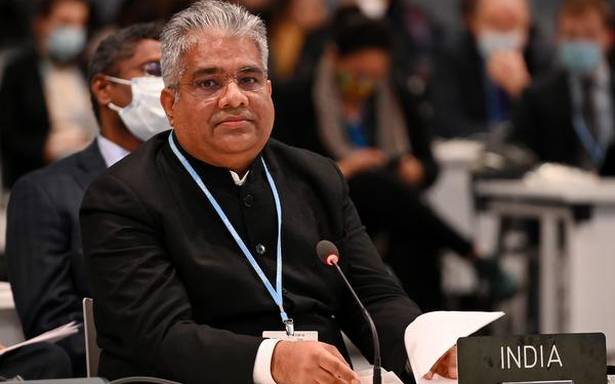‘The Glasgow Climate Pact, combined with increased ambition and action from countries, means that 1.5C remains in sight, but it will only be delivered with concerted and immediate global efforts,’ says a statement.
The 26th United Nations Conference of Parties (COP) in Glasgow concluded late on Saturday, local time, with a resolution by countries to “revisit and strengthen” their existing emission targets by 2022.
Explained | How do India’s net zero goal stack up?
“The Glasgow Climate Pact, combined with increased ambition and action from countries, means that 1.5C remains in sight, but it will only be delivered with concerted and immediate global efforts,” said a statement from the United Nations Secretariat. The Paris Agreement, a treaty signed in 2015, exhorts countries to strive to curtail emissions that would prevent temperatures from rising over 1.5C by 2100. This would require significant adaptation to renewable energy, cutting global emissions by as much as 45% by 2030 and effectively zero emissions by mid-century.
A major target when negotiations began on November 1 was to tie up loose ends from 2015 Paris Agreement. The Paris Rulebook, that specifies guidelines for how the Paris Agreement is delivered, was also completed today after six years of discussions. “This will allow for the full delivery of the landmark accord, after agreement on a transparency process which will hold countries to account as they deliver on their targets. This includes Article 6, which establishes a robust framework for countries to exchange carbon credits through the UNFCCC,” the statement noted.
India was among the countries that had insisted on clarity on Article 6 because a bulk of the carbon credits accumulated by its several companies — private and public sector enterprises — over a decade were infructuous and India had pushed for them to be made valid again. Carbon credits allow companies in developed countries to indirectly pay for clean energy transitions in developing countries by accumulating credits. However, criticism mounted that that was not actually leading to measurable reductions in overall polluting emissions and the 1997 Kyoto Protocol that validated carbon credit trading had expired in 2020.
A key thrust of COP 26, led by the United States and the United Kingdom, which held the presidency this time, was to have countries such as India and China agree to a year, preferably mid-century, by which their emissions would be near zero. This would also imply phasing out coal. However India, in a last minute intervention and supported by China, opposed such wording in the text of the agreement. As a compromise, it now reads that coal will not be “phased out” but “phased down.”
The U.K. Presidency noted that as recently as 2019, only 30% of the world was covered by net zero targets and this had now moved close to 90%. Over the same period, 154 Parties (of the nearly 200) had submitted new national targets, representing 80% of global emissions.
India’s net zero commitment at CoP 26, explained | In Focus Podcast
“The U.K. Presidency has also been focused on driving action to deliver emissions reductions. We have seen a huge shift in coal, with many more countries committing to phase out unabated coal power and ending international coal financing,” the statement noted.
“We can now say with credibility that we have kept 1.5 degrees alive. But its pulse is weak and it will only survive if we keep our promises and translate commitments into rapid action. I am grateful to the UNFCCC for working with us to deliver a successful COP26,” COP President, Alok Sharma, said in a statement, “From here, we must now move forward together and deliver on the expectations set out in the Glasgow Climate Pact, and close the vast gap which remains.”
Long-time COP-watchers said that despite progress on future emissions reductions, COP26 failed those most impacted by the climate crisis now. “The COP26 has definitely narrowed the gap for 1.5 and the processes which can be taken for future action. But the failure of the U.S. and EU to deliver on the promised $100 billion in climate finance remains urgent and central to any ambitious climate action. Blocking the establishment of even a modest fund to help vulnerable communities around the world with the massive loss and damage they are experiencing at the hands of the climate crisis is a serious blow. As with COVID, those with the least resources have been left to fend for themselves,” said Arti Khosla, Director, Climate Trends.
India had indicated that it needed a trillion dollars in the coming decade to be able to meet its 2030 committent – that Prime Minister Narendra Modi announced at Glasgow — to increase the use of non-fossil sources of energy by 500 GW, decarbonise its railways and increase its emissions intensity. It also appeared to suggest that it would “update its Nationally Determined Contributions” only on getting assurances about this. However, the text of the agreement indicates that all countries should deliver climate plans to the U.N. on five-year cycles and using a common time frame for NDCs starting 2025 (with countries submitting 2035 NDCs in 2025, 2040 NDCs in 2030).
Source: Read Full Article

